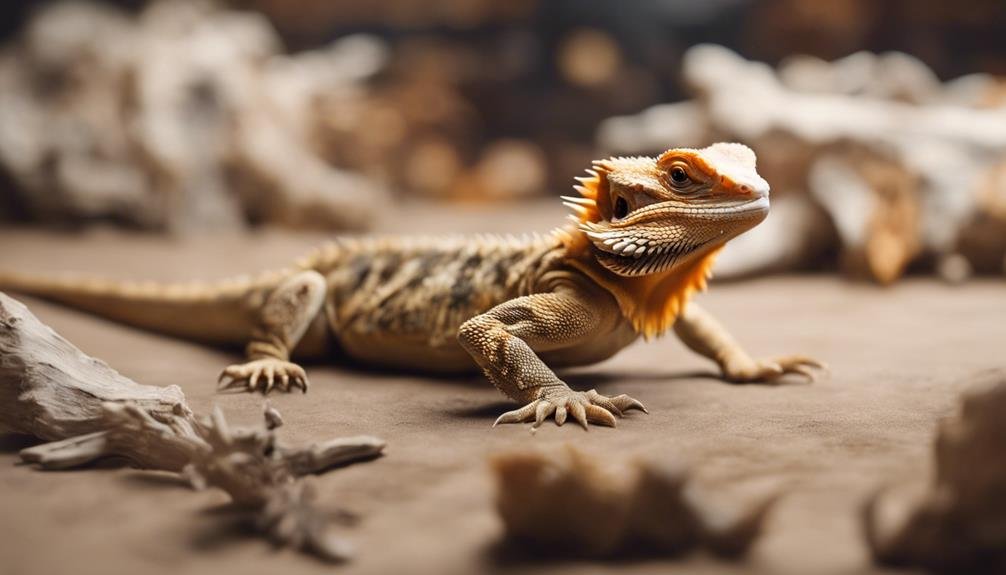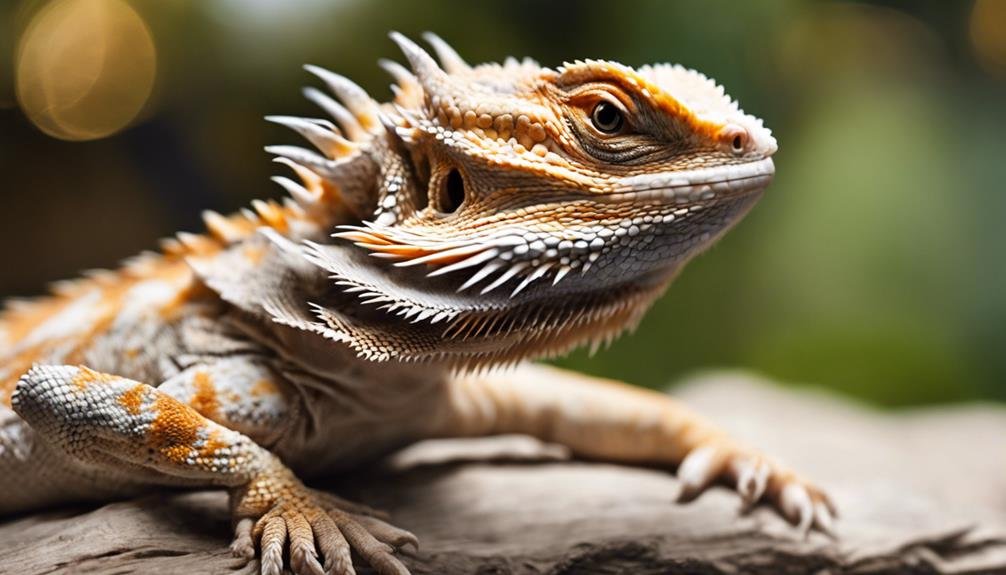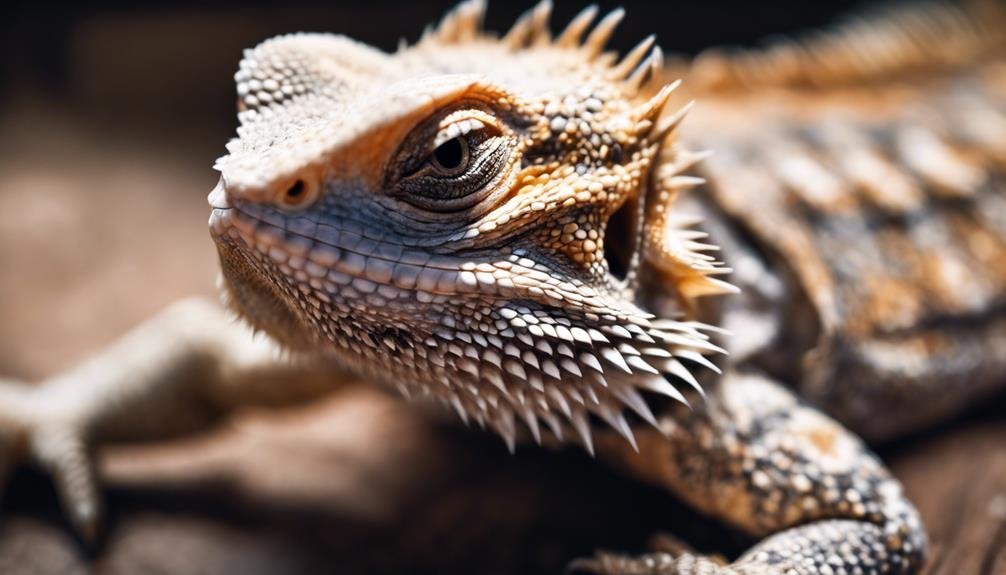If you're curious about when your bearded dragon begins its shedding process, it's important to understand the signs and what triggers it. Shedding, or ecdysis, is a natural occurrence that allows your bearded dragon to grow and renew its skin. You'll notice signs like a duller skin appearance, lethargy, and perhaps a decrease in appetite. But what exactly prompts this change, and how can you guarantee it's a smooth process for your pet? Stay with us as we uncover the intricacies of the shedding process, from the reasons behind it to providing the best care your bearded dragon needs during this critical period.
Key Takeaways
- Bearded dragons shed throughout their lives, more frequently as babies due to rapid growth.
- Adult dragons typically shed once or twice a year as growth slows.
- Signs of impending shed include lethargy, reduced appetite, irritability, and a dull skin appearance.
- Shedding is triggered by growth, skin damage, stress, and sometimes malnutrition or parasites.
- Maintaining proper humidity and hydration assists in a smoother shedding process.
Shedding Process Explained
Bearded dragons shed their skin to accommodate their growing bodies and renew their outer layer. This essential process is crucial for their health, allowing them to replace dead skin cells and enhance their ability to absorb calcium. As you watch your bearded dragon go through this, keep in mind that shedding signifies the growth of new skin cells, a clear indicator of their development.
The frequency of shedding varies greatly throughout their life. Baby dragons, because they're growing at a quicker pace, tend to shed more often, sometimes as frequently as weekly. On the other hand, adult bearded dragons don't grow as much, so their need to shed reduces to maybe just once or twice a year. This doesn't mean they've stopped growing entirely; it's just a slower process that doesn't require as frequent shedding.
Understanding the shedding process helps you provide better care for your pet. It's a natural, crucial part of their growth and health. So, when you notice your bearded dragon beginning to shed, remember, it's a sign of good health and normal development.
Reasons for Shedding
Several factors trigger shedding in bearded dragons, including growth, skin damage, and stress. As your bearded dragon grows, shedding becomes essential for accommodating its increasing size. Young dragons shed more frequently due to rapid growth spurts, making room for their new, larger bodies. Shedding also helps heal skin damage by removing the damaged layer and replacing it with new, healthy skin.
Conditions like malnutrition and external parasites can prompt shedding as they disrupt the normal condition of the skin. Stressful environments can also lead to irregular shedding patterns. Monitoring these factors is crucial for ensuring your bearded dragon's skin health.
As bearded dragons transition from juveniles to adults, shedding frequency decreases. This slowdown is attributed to the reduced growth rate in adult dragons. Although shedding may occur less often, it remains essential for maintaining overall skin health and hygiene.
Shedding Frequency


Understanding how often your bearded dragon sheds can offer valuable insights into its health and growth stages. The shedding frequency of bearded dragons is a clear indicator of their development and well-being. Younger dragons, experiencing rapid growth, will shed their skin more often, sometimes as frequently as weekly. This high frequency is necessary to accommodate their quickly expanding bodies.
As your bearded dragon matures, you'll notice a decrease in how often they shed. Adult bearded dragons shed far less frequently, typically only once or twice a year. This slowdown is directly tied to their reduced growth rate as they reach full size. Monitoring shedding frequency is essential; it's a tangible metric that can help you make sure your bearded dragon is healthy. Healthy bearded dragons follow a predictable pattern of shedding that correlates with their age and growth phase.
Signs of Impending Shed
As your bearded dragon approaches shedding time, you'll notice several clear signs. Their skin may appear dull and grayish, while their typical behavior patterns, like energy levels and appetite, might change.
These variations are your clues that it's time for their skin to renew.
Changed Behavior Patterns
Bearded dragons often show signs like lethargy and decreased appetite when they're about to shed. This period can be puzzling if you're not aware of the changed behavior patterns that signal an impending shed. Besides a general lack of energy and reduced food intake, you might also notice your pet becoming more irritable than usual. These shifts can be concerning, but understanding them as part of the natural shedding process can ease your worries.
To grab your attention, here are three key behaviors to watch for:
- Lethargy: An unusual level of inactivity or sluggishness.
- Reduced Food Intake: A noticeable decrease in appetite and interest in food.
- Irritability: Increased sensitivity and a desire to be left alone, avoiding handling more than usual.
Dull Skin Appearance
A noticeable shift to dull, grayish skin marks the beginning of your bearded dragon's shedding process.
This dull skin appearance is a clear sign that the imminent shedding process is near, indicating your pet is preparing to shed its old skin.
The change in skin color to a more faded, lackluster hue is a common indicator that your bearded dragon is gearing up for this natural occurrence.
Observing a lack of vibrancy in their skin isn't a cause for alarm, but rather a natural part of their growth cycle.
It's crucial to recognize these subtle changes, as they indicate your bearded dragon is about to commence on the shedding process, renewing its skin and appearance.
Appetite Variations
Noticing your bearded dragon's diminished interest in food can be a telltale sign they're getting ready to shed. This lack of appetite during the shedding process is a natural response to the skin discomfort they experience. The tightness of their skin before it begins to peel away can make them feel less inclined to eat.
Here are three key points to keep in mind:
- Appetite variations signal an impending shed.
- Reduced interest in food is due to skin tightness and discomfort.
- Monitoring appetite changes can help you predict when the shedding cycle will start.
Understanding these signs and monitoring your bearded dragon's appetite can provide valuable insights into their health and well-being, especially as they prepare for the shedding process.
Shedding Assistance Tips
As your bearded dragon begins shedding, paying attention to humidity and hydration becomes essential in easing the process.
Gentle aids, such as misting or providing a shedding box, can greatly help their skin loosen without causing stress or harm.
Humidity and Hydration
To support your bearded dragon's shedding process, it's essential to maintain humidity levels within the 30-40% range and make sure they're well hydrated. Proper humidity and hydration are vital to soften the old skin, making the shedding smoother and preventing complications. Here are three key tips to guarantee ideal conditions:
- Monitor Humidity Regularly: Use a hygrometer to keep track of humidity levels in the enclosure, adjusting as necessary to avoid dry, stubborn sheds.
- Provide Shallow Baths: A shallow, lukewarm bath can greatly aid hydration and the shedding process.
- Mist the Enclosure: Gently misting your bearded dragon's habitat can increase humidity, helping to loosen any difficult shed.
Gentle Shedding Aids
After ensuring your bearded dragon is well-hydrated and the humidity levels are ideal, there are additional gentle methods you can employ to aid their shedding process. Providing shallow warm baths can help soften their skin, making it easier for the old layers to come off.
Introducing a rough surface, such as sandpaper or rocks, allows them to rub against and facilitate the removal of dead skin. If you notice areas where the shed seems stuck, using a soft toothbrush or damp cloth to gently rub these spots can help loosen the shed.
Additionally, misting their enclosure to increase humidity supports a more efficient shedding process. Remember, never forcefully pull or peel the skin, as this can hurt your bearded dragon.
Common Shedding Issues


While shedding is a natural process for bearded dragons, certain issues can complicate this period, leading to health concerns. Understanding these issues can help you provide the best care for your pet.
Here are three common shedding issues you should be aware of:
- Retained Shed: This occurs when pieces of shedding skin don't come off completely. It's often due to dehydration or improper humidity levels. Retained shed can lead to restricted blood flow, especially around the toes and tail, which can cause serious health problems.
- Dehydration: Dehydration can greatly hinder the shedding process. Bearded dragons need adequate hydration for shedding skin to come off smoothly. Make sure they've access to fresh water and consider regular misting to help maintain ideal humidity levels.
- Skin Infections: Improper diet and environmental conditions can lead to skin infections during shedding. These infections can complicate the shedding process and cause discomfort or even more severe health issues. Regular monitoring and maintaining a clean habitat are essential to prevent these complications.
Additional Care Advice
In addition to addressing common shedding issues, there are several steps you can take to further support your bearded dragon during this process. One effective method is providing a humid hide, which can greatly ease the shedding process. This setup helps maintain the right level of humidity around your pet, making it easier for them to shed old skin.
Additionally, you might consider offering a shedding box filled with damp moss or paper towels. This not only aids in the shedding process but also offers a safe and comfortable environment for your bearded dragon to work through any shedding problems. It's a simple yet impactful part of shedding care that can make a big difference.
Gently misting the enclosure can also provide the additional moisture needed for an effective shed. However, it's vital to strike a balance to avoid creating overly humid conditions that could lead to other issues. Make sure the habitat is well-ventilated to prevent excessive humidity buildup.
Can Bearded Dragons Shed in Water?
Bearded dragons can shed in water, as some are known to have bearded dragon water preferences. Providing a shallow dish for them to soak in can help with shedding, hydration, and overall health. It’s essential to monitor their behavior and ensure the water temperature is suitable for them.
Frequently Asked Questions
How Do You Know if Your Bearded Dragon Is Starting to Shed?
You'll know your bearded dragon's starting to shed if you notice a few key signs. Their skin texture changes, becoming tighter and duller, sometimes even whitish. Shedding behavior ramps up, like more scratching or rubbing against things.
Age factors in, as younger dragons shed more often. Check if your tank's environmental humidity is right; it can affect shedding. Providing shedding aids like logs can help them shed easier, too.
What Does a Bearded Dragon Look Like Before Shedding?
Before your bearded dragon starts shedding, you'll notice several changes. Its skin becomes dull and might show color changes, appearing grayish. The skin's texture also tightens, looking less vibrant.
You might see behavior changes, such as reduced activity or more scratching and rubbing against surfaces. Their eyes can seem cloudy, sometimes bulging, indicating they're ready to shed.
Additionally, shedding patches appear, signaling the beginning of the shedding process.
How Long Does the Shedding Process Take for Bearded Dragons?
Your bearded dragon's shedding process can vary. Typically, it takes 2-3 weeks, but age factors in—juveniles may shed within a week. Shedding aids like maintaining proper humidity levels and ensuring good skin health are essential.
You'll also notice behavioral changes; they might seem more irritable. Watch for partial sheds, which take about a week. Keeping an eye on these aspects can help you better care for your pet during this time.
Do Bearded Dragons Stop Eating Before They Shed?
Yes, you might notice your bearded dragon stops eating before they shed. This is due to appetite changes that often accompany their shedding diets. It's a stress behavior but don't worry, it's important.
Keep an eye on their hydration; it's vital during this time. Environmental factors also play a role, so make sure their habitat supports their needs.
This reduced food intake is temporary and should return to normal after they've shed.
Conclusion
In short, your bearded dragon's shedding is a natural, necessary process that supports their growth and health. Keep an eye out for signs like dull skin and irritability, signaling it's time to provide a helping hand.
Remember, frequent sheds are common in youngsters, while adults take it slower. If shedding gets patchy or seems off, it might hint at deeper issues.
So, offer plenty of baths, maintain humidity, and make sure their habitat is on point for a smooth shedding journey.


